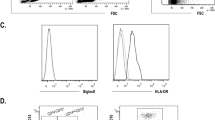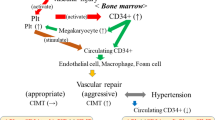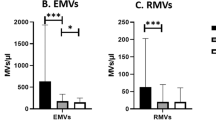Abstract
CD34+ and CD34+VEGFR2+ cells participate in the repair of damaged endothelium and vascular remodelling. As their number and activity change due to the development of cardiovascular diseases, they are recognised as useful markers of cardiovascular health. As ineffective blood pressure control concerns high percentage of hypertensive patients, the purpose of our study was to investigate if proportions of various CD34+ and CD34+VEGFR2+ populations change due to hypertension occurrence and the effectiveness of the therapy. We also wanted to establish which factors impact these cells. Circulating populations of CD34+ and CD34+VEGFR2+ cells were analysed in peripheral blood samples by flow cytometry. Serum/plasma levels of sICAM-1, sVCAM-1 and vWF were determined using immunoenzymatic assay. We did not observe differences in CD34+ populations, but proportions of CD34+VEGFR2+ (p = 0.006), CD34+VEGFR2+CD133+ (p = 0.002) and CD34+VEGFR2+c-Kit+ (p = 0.003) cells were reduced in patients with poorly controlled blood pressure. We have also established that these cells exhibit connections with age, blood pressure and sICAM-1 serum levels. However, multiparametric regression analyses did not indicate any of the analysed variables as independent factors affecting CD34+VEGFR2+ populations. CD34+VEGFR2+, CD34+VEGFR2+CD133+ and CD34+VEGFR2+c-Kit+ cells are reduced in poorly controlled hypertensive patients, which may be partially connected with increased cardiovascular complications and mortality observed in this group.
This is a preview of subscription content, access via your institution
Access options
Subscribe to this journal
Receive 12 digital issues and online access to articles
$119.00 per year
only $9.92 per issue
Buy this article
- Purchase on Springer Link
- Instant access to full article PDF
Prices may be subject to local taxes which are calculated during checkout

Similar content being viewed by others
References
Yu Y, Fukuda N, Yao EH, Matsumoto T, Kobayashi N, Suzuki R, et al. Effects of an ARB on endothelial progenitor cell function and cardiovascular oxidation in hypertension. Am J Hypertens. 2008;21:72–77.
Van Zonneveld AJ, Rabelink TJ. Endothelial progenitor cells: biology and therapeutic potential in hypertension. Curr Opin Nephrol Hypertens. 2006;15:167–72.
Fadini GP, Agostini C, Sartore S, Avogaro A. Endothelial progenitor cells in the natural history of atherosclerosis. Atherosclerosis. 2007;194:46–54.
Werner N, Wassmann S, Ahlers P, Schiegl T, Kosiol S, Link A, et al. Endothelial progenitor cells correlate with endothelial function in patients with coronary artery disease. Basic Res Cardiol. 2007;102:565–71.
Li TS, Hamano K, Nishida M, Hayashi M, Ito H, Mikamo A, et al. CD117 + stem cells play a key role in therapeutic angiogenesis induced by bone marrow cell implantation. Am J Physiol Heart Circ Physiol. 2003;285:931–7.
Rolland-Turner M, Goretti E, Bousquenaud M, Léonard F, Nicolas C, Zhang L, et al. Adenosine stimulates the migration of human endothelial progenitor cells. Role of CXCR4 and microRNA-150. PLoS ONE. 2013;8:e54135.
Sainz J, Sata M. CXCR4, a key modulator of vascular progenitor cells. Arterioscler Thromb Vasc Biol. 2007;27:263–5.
Witkowska AM, Borawska MH. Soluble intercellular adhesion molecule-1 (sICAM-1): an overview. Eur Cytokine Netw. 2004;15:91–8.
Jenny NS, Arnold AM, Kuller LH, Sharrett AR, Fried LP, Psaty BM, et al. Soluble intracellular adhesion molecule-1 is associated with cardiovascular disease risk and mortality in older adults. J Thromb Haemost. 2006;4:107–13.
Arnett D, Claas S, Glasser S. Pharmacogenetics of antihypertensive treatment. Vasc Pharmacol. 2006;44:107–18.
Wilimski R, Niewada M. Costs of ineffective hypertension treatment. Arter Hypertens. 2006;10:551–60.
D’Agostino RB, Vasan RS, Pencina MJ, Wolf PA, Cobain M, Massaro JM, et al. General cardiovascular risk profile for use in primary care: the Framingham Heart Study. Circulation. 2008;117:743–53.
Shimizu Y, Sato S, Koyamatsu J, Yamanashi H, Nagayoshi M, Kadota K, et al. Circulating CD34-positive cells, glomerular filtration rate and triglycerides in relation to hypertension. Atherosclerosis. 2015;2431:71–6.
Coppolino G, Bolignano D, Campo S, Loddo S, Teti D, Buemi M. Circulating progenitor cells after cold pressor test in hypertensive and uremic patients. Hypertens Res. 2008;31:717–24.
Fadini GP, de Kreutzenberg SV, Coracina A, Baesso I, Agostini C, Tiengo A, et al. Circulating cd34 + cells, metabolic syndrome, and cardiovascular risk. Eur Heart J. 2006;27:2247–55.
Giannotti G, Doerries C, Mocharla PS, Mueller MF, Bahlmann FH, Horvàth T, et al. Impaired endothelial repair capacity of early endothelial progenitor cells in prehypertension relation to endothelial dysfunction. Hypertens . 2010;55:1389–97.
Mandraffino G, Imbalzano E, Sardo MA, D’Ascola A, Mamone F, Lo Gullo A, et al. Circulating progenitor cells in hypertensive patients with different degrees of cardiovascular involvement. J Hum Hypertens. 2014;28:543–50.
Bettencourt N, Oliveira S, Toschke AM, Rocha J, Leite D, Carvalho M, et al. Predictors of circulating endothelial progenitor cell levels in patients without known coronary artery disease referred for multidetector computed tomography coronary angiography. Rev Port Cardiol. 2011;30:753–60.
Schmidt-Lucke C, Rössig L, Fichtlscherer S, Vasa M, Britten M, Kämper U, et al. Reduced number of circulating endothelial progenitor cells predicts future cardiovascular events: proof of concept for the clinical importance of endogenous vascular repair. Circulation. 2005;111:2981–7.
Pelliccia F, Pasceri V, Cianfrocca C, Vitale C, Speciale G, Gaudio C, et al. Angiotensin II receptor antagonism with telmisartan increases number of endothelial progenitor cells in normotensive patients with coronary artery disease: a randomized, double-blind, placebo controlled study. Atherosclerosis. 2010;210:510–5.
Chen Z, Herrmann SM, Zhu X, Jordan KL, Gloviczki ML, Lerman A, et al. Preserved function of late-outgrowth endothelial cells in medically treated hypertensive patients under well-controlled conditions. Hypertension . 2014;64:808–14.
Magen E, Feldman A, Cohen Z, Alon DB, Minz E, Chernyavsky A, et al. Circulating endothelial progenitor cells, Th1/Th2/Th17-related cytokines, and endothelial dysfunction in resistant hypertension. Am J Med Sci. 2010;339:117–22.
Chae CU, Lee RT, Rifai N, Ridker PM. Blood pressure and inflammation in apparently healthy men. Hypertension. 2001;38:399–403.
Ferri C, Desideri G, Valenti M, Bellini C, Pasin M, Santucci A, et al. Early upregulation of endothelial adhesion molecules in obese hypertensive men. Hypertension. 1999;34:568–73.
Cohen KS, Cheng S, Larson MG, Cupples LA, McCabe EL, Wang YA, et al. Circulating CD34+ progenitor cell frequency is associated with clinical and genetic factors. Blood. 2013;121:50–6.
Povsic TJ, Zhou J, Adams SD, Bolognesi MP, Attarian DE, Peterson ED. Aging is not associated with bone marrow-resident progenitor cell depletion. J Gerontol A Biol Sci Med Sci. 2010;65:1042–50.
Heiss C, Keymel S, Niesler U, Ziemann J, Kelm M, Kalka C. Impaired progenitor cell activity in age-related endothelial dysfunction. J Am Coll Cardiol. 2005;45:1441–8.
Dimmeler S, Leri A. Aging and disease as modifiers of efficacy of cell therapy. Circ Res. 2008;102:1319–30.
Williamson K, Stringer SE, Alexander MY. Endothelial progenitor cells enter the aging arena. Front Physiol. 2012;3:30.
Gunji Y, Nakamura M, Hagiwara T, Hayakawa K, Matsushita H, Osawa H. Expression and function of adhesion molecules on human hematopoietic stem cells: CD34 + LFA-1- cells are more primitive than CD34 + LFA-1 + cells. Blood. 1992;80:429–36.
Leeuwenberg J, Smeets E, Neefjes J, Shaffer M, Cinek T, Jeunhomme T, et al. E-selectin and intercellular adhesion molecule-1 are released by activated human endothelial cells in vitro. Immunology. 1992;77:543–9.
Kröger N, Zeller W, Hassan HT, Dierlamm J, Zander AR. Difference between expression of adhesion molecules on CD34 + cells from bone marrow and G-CSF-stimulatedperipheral blood. Stem Cells. 1998;16:49–53.
Mohle R, Moore MA, Nachman RL, Rafii S. Transendothelial migration of CD34 + and mature hematopoietic cells: an in vitro study using a human bone marrow endothelial cell line. Blood. 1997;1:72–80.
Lee SP, Youn SW, Cho HJ, Li L, Kim TY, Yook HS, et al. Integrin-linked kinase, a hypoxia-responsive molecule, controls postnatal vasculogenesis by recruitment of endothelial progenitor cells to ischemic tissue. Circulation. 2006;114:150–9.
Acknowledgements
The paper was subsided by the grants of National Science Centre Nr 2011/01/B/NZ5/00345 and 2012/07/B/NZ5/00017. The funders had no role in the study design, data collection and analysis, decision to publish, or preparation of the manuscript.
Author information
Authors and Affiliations
Corresponding author
Ethics declarations
Conflict of interest
The authors declare that they have no conflict of interest.
Rights and permissions
About this article
Cite this article
Skrzypkowska, M.W., Gutknecht, P.G., Ryba-Stanisławowska, M.E. et al. CD34+ and CD34+VEGFR2+ cells in poorly controlled hypertensive patients. J Hum Hypertens 33, 863–872 (2019). https://doi.org/10.1038/s41371-018-0145-z
Received:
Revised:
Accepted:
Published:
Issue Date:
DOI: https://doi.org/10.1038/s41371-018-0145-z



